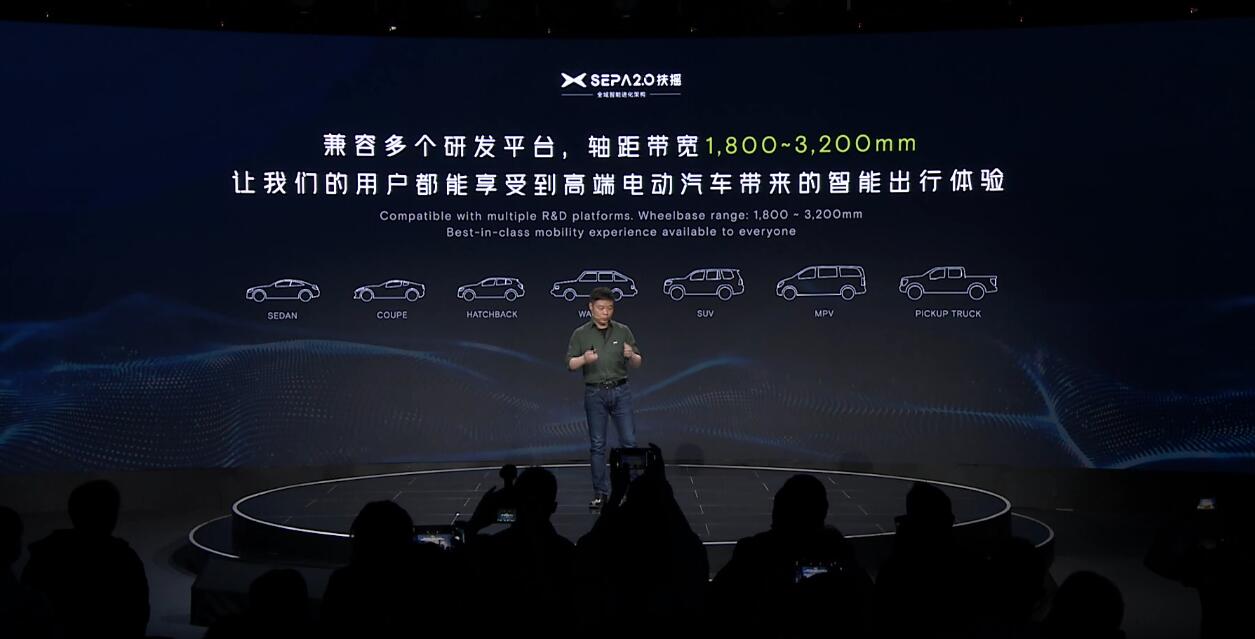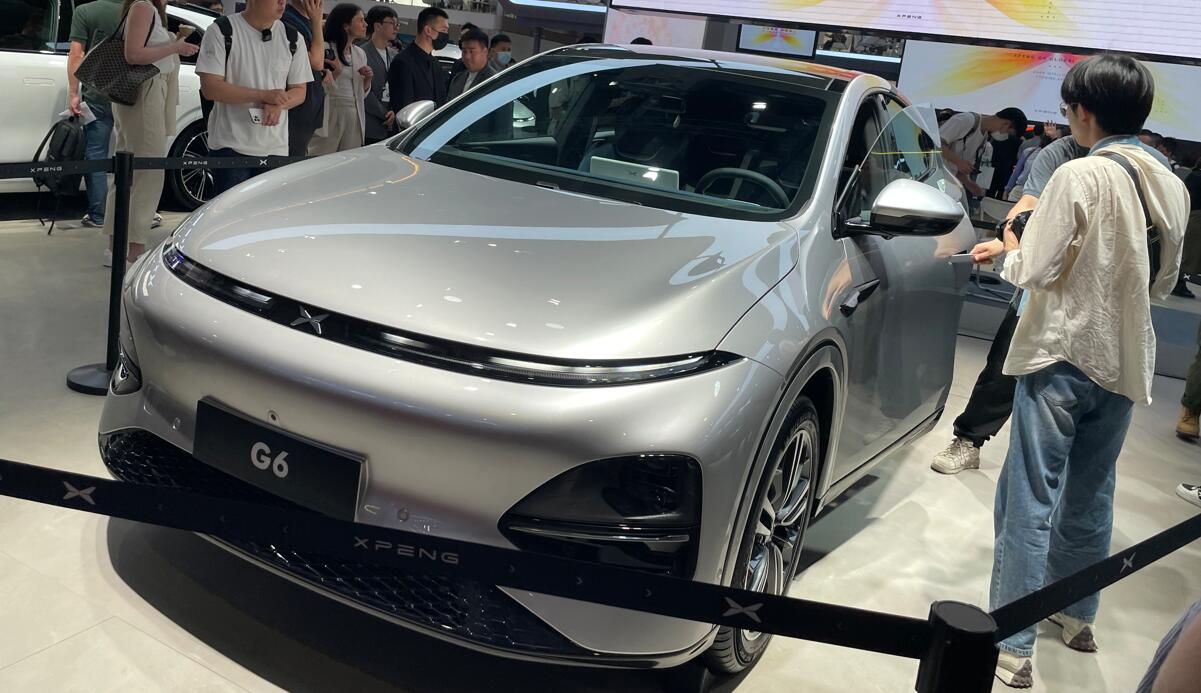The G6 will be the first new model built on SEPA 2.0, and Xpeng will soon launch 10 new models based on the new platform with greater cost savings.

Xpeng (NYSE: XPEV) has unveiled its next-generation vehicle technology architecture, which it hopes will help it stay relevant in an increasingly competitive market.
The electric vehicle (EV) maker unveiled the architecture, called SEPA (Smart Electric Platform Architecture) 2.0, at a launch event in Shanghai today, saying that the new SUV G6, which will be unveiled on the first day of the Shanghai auto show on April 18, will be the first new model to be built on SEPA 2.0.
The Shanghai auto show will be held at the National Exhibition and Convention Center from April 18-27, with media days from April 18-19, professional visitor days from April 20-21, and general public admission from April 22-27.
SEPA 2.0 brings more advanced architectural solutions to support Xpeng's full-stack in-house development from autonomous driving software to vehicle engineering, the company said.
The architecture will shorten the R&D cycle of future models by 20 percent and optimize development efficiency significantly. Interchangeability and interoperability of common and modular components between new models will reach 80 percent, enabling Xpeng to meet diverse customer needs at an optimized cost, it said.
SEPA 2.0 is adaptable and flexible for multiple vehicle platforms with wheelbases between 1,800 mm and 3,200 mm and can be expanded to support a wide range of vehicle types, including sedan, coupe, hatchback, wagon, SUV, MPV and pickup truck.

"We envision that this evolutionary intelligent architecture will lead smart EV technology development for the next three years. It will make rapid advancements in technology available for our customers as standard, with faster software upgrades, stunning cost savings and elevated product experience," said Xpeng chairman and CEO, He Xiaopeng.
Mr. He believes that reaching 3 million units in annual sales is the foundation for an electric vehicle company to stay in the game, while cost control, efficient R&D, and high-end experience are necessary for survival and will be the basis for globalization efforts.
Over the past five years, Xpeng has invested more than RMB 10 billion ($1.46 billion) in R&D on vehicle architecture, Mr. He said, adding that based on a better platform, Xpeng will soon launch 10 new models with greater cost savings.

Technical details of new platform
SEPA 2.0 will accelerate the inclusion of Xpeng's smart technologies including XNGP Advanced Driver Assistance System (ADAS), Xmart OS in-car operating system, and X-EEA electrical and electronic architecture, the company said.
With the SEPA 2.0 architecture, the overall R&D efficiency of Xpeng's in-house developed full-scenario ADAS solution XNGP will be increased by 30 percent and the cost of ADAS software model adaptation will be reduced by 70 percent, according to Mr. He.
XNGP is the ultimate form of driver assistance, and all of Xpeng's future models in the Chinese market will be equipped with it as standard, according to Mr. He.
Backed by its autonomous driving supercomputing center, XNGP will continue to evolve and upgrade its assisted driving skills with the goal of taking over less than once per 1,000 kilometers for highway scenarios by 2023 and less than once per 100 kilometers for urban scenarios by 2025.
Based on the SEPA 2.0 R&D platform, Xmart OS software adaptation cost will be reduced by 85 percent, voice software development cycle will be reduced by 50 percent, and voice assistant service cost will be reduced by 50 percent, according to Xpeng.
Xmart OS leverages a multi-sensor software and hardware platform to enhance and transform control and driver-vehicle interaction. Powered by artificial intelligence, supercomputers and underlying models, Xmart OS can make intelligent decisions to optimize control of cabin functions, the company said.
Xpeng's X-EEA electrical and electronic architecture allows for 50 percent optimization of overall vehicle development costs, a 30 percent reduction in software iteration cycles and a 300 percent increase in OTA update speed, it said.
The company's architecture-based solutions improve charging efficiency, which includes an 800-volt high-voltage silicon carbide (SiC) platform that allows batteries to be charged 50 percent faster than the previous generation.
Xpeng's latest platform uses a standard 3C battery configuration with a battery that adds 130 kilometers of vehicle range in five minutes and can be charged faster at its S4 supercharger facility, adding 200 kilometers of range in five minutes, according to the company.
The company's in-house developed XPower 800-volt high-voltage oil-cooled flat-wire silicon carbide integrated powertrain system increases maximum powertrain efficiency to 97.5 percent and overall powertrain efficiency to 92 percent, it said.

The X-HP smart thermal management system provides an intelligent, systematic energy-saving solution that increases range by 15 percent in cold conditions. It also improves battery cooling performance by 100 percent, resulting in a 90 percent increase in charging power.
Xpeng will use integrated aluminum die-casting technology on the SEPA 2.0 architecture to deliver more stable handling and better driving performance.
The integrated die-cast body gives 83 percent more torsional rigidity than a conventional body, while the body weight is 17 percent less than a conventional body, further improving range.
The architecture also includes CIB (Cell Integrated Body) technology, which allows the battery pack to be integrated into the body, not only increasing vertical space, but also improving battery safety, according to Xpeng.
The CIB battery pack features an 80-ton side-impact resistant design and an IP68 water and dust resistant design that meets the highest safety standards in three major markets: China, North America and Europe, it said.
Xpeng's chassis platform will be compatible with a wide range of suspension systems, providing superior mechanical quality and excellent handling performance, it said.
Xpeng aims to have an intelligent manufacturing system in place by 2025, including the Zhaoqing plant, the Guangzhou base and several future projects, with all manufacturing facilities integrated with SEPA 2.0 through technology upgrades.
First model based on SEPA 2.0 coming soon
The first new model based on the SEPA 2.0, the Xpeng G6 coupe SUV, will be unveiled at the Shanghai auto show on April 18, the company said. Xpeng's previous announcement showed it would hold a launch event on April 18 from 9:40-10:00 am.
Xpeng did not reveal more information about the G6 today, although information about the specifications of the SEPA 2.0 platform suggests that the model will be based on the 800 V platform and will be more cost-efficient.
On March 17, Xpeng management said during the company's Q4 earnings call that the G6, a new energy SUV with a price range of RMB 200,000-300,000, will be officially launched and delivered by the end of the second quarter.
Xpeng's monthly sales target for the G6 is two to three times that of the P7, Mr. He said during that call.
The G6 will have a significantly improved range that will exceed expectations and will have much more interior space than similar offerings from competitors, he said previously.
In a research note sent to investors on March 22, Deutsche Bank analyst Edison Yu's team said the upcoming G6 will be the swing factor that the model will need to succeed in order to make Xpeng truly relevant in the market again.
Xpeng will likely price the G6 similarly to the Tesla Model Y, hoping to attract consumers with its sleeker design and updated interior, the team said.
With increased G6 production, Xpeng management believes total monthly deliveries could reach 15,000 units at some point in the third quarter, the team noted.
"This seems achievable and we model Xpeng reaching this level in Sep," Yu's team previously wrote.
($1 = RMB 6.8714)



